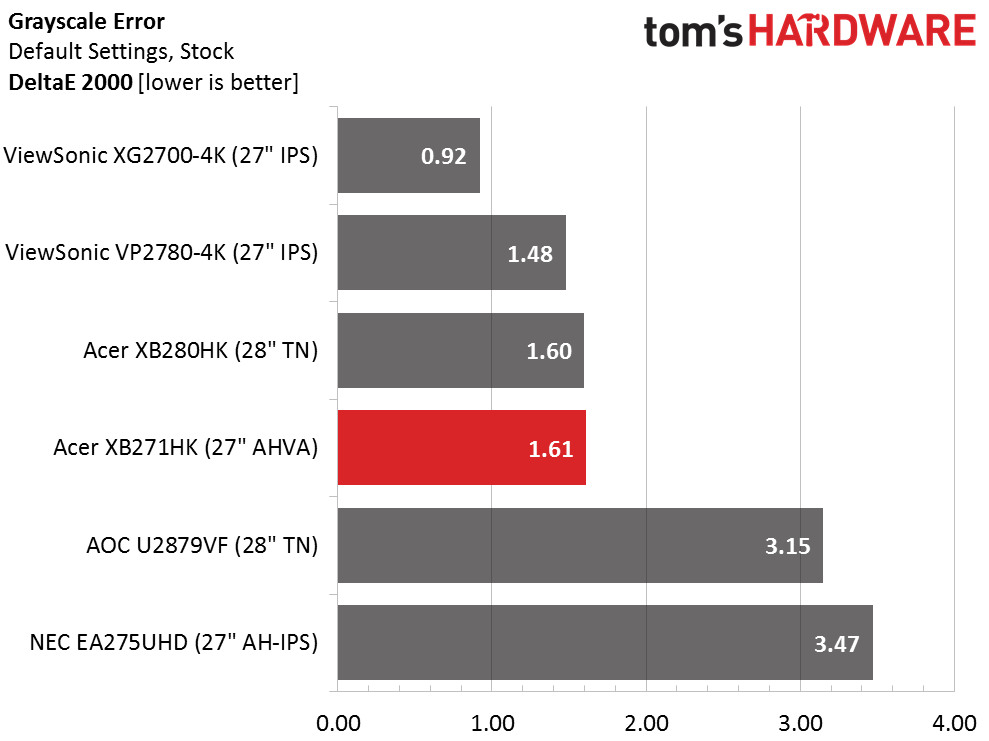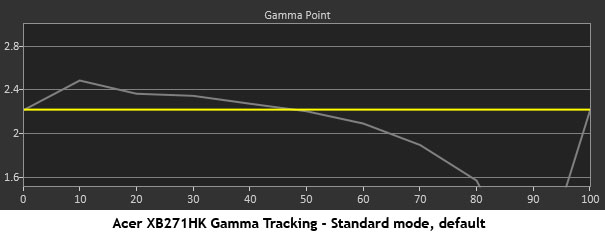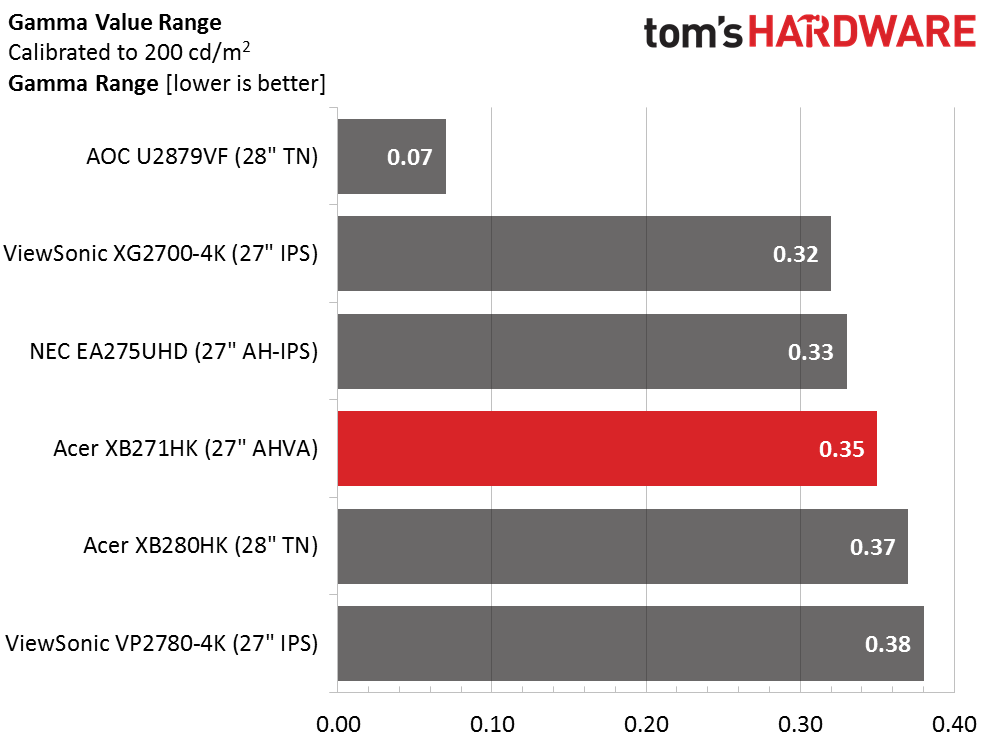Acer Predator XB271HK 27-inch UHD G-Sync Monitor Review
Gamers seeking Ultra HD resolution have few choices but an excellent new G-Sync monitor has just appeared from Acer, the XB271HK sporting a 27-inch AHVA screen. We’re checking it out in our lab today.
Why you can trust Tom's Hardware
Grayscale Tracking And Gamma Response
Our grayscale and gamma tests are described in detail here.
This is an excellent out-of-box result for any monitor. The RGB levels indicate a little warmth, but our deltaE chart shows no visible errors. You can leave the XB271HK on its warm color temp preset, but below we’ll make a couple of recommendations for changes in gamma and contrast.
Dropping the red slider two clicks improves the result slightly. You won’t be able to see the difference, but as always we want to show the monitor’s maximum potential for accuracy.
Here is our comparison group.
The top four displays here can all be used without calibration. The AOC and NEC monitors show slightly visible tints to their white points but nothing too egregious.
That tweak to the red slider has dropped the XB271HK’s average grayscale error down to 1.15dE. While not quite in professional territory like the XG2700-4K, it performs more than respectably.
Gamma Response
Our initial gamma measurement made us believe some sort of dynamic contrast was in play. It turned out the problem comes from a contrast control that’s set too high. Most monitors we test don’t need adjustment in this area but the XB271HK benefits greatly when you drop the slider from 50 to 42.
Get Tom's Hardware's best news and in-depth reviews, straight to your inbox.
If you only adjust Contrast the gamma will be too dark, so we also changed the preset to 1.8 from its 2.2 default setting. It seems like a large swing on paper but our measured result is pretty good. We’d prefer to see finer control with clicks no more than .2 apart, but in this case, things work out fine.
Here is our comparison group again.
All of the screens here sport tight gamma tracking. Even a .38 range of values is a nearly-invisible error. In the XB271HK’s case, there is a slight peak at 10 percent and an equally small dip at 90. Neither of these are errors of consequence.
We calculate gamma deviation by simply expressing the difference from 2.2 as a percentage.
A .04 percent deviation represents a raw difference of .01. Our sample measured 2.21 for its gamma average. It doesn’t get much better.
Current page: Grayscale Tracking And Gamma Response
Prev Page Brightness And Contrast Next Page Color Gamut And Performance
Christian Eberle is a Contributing Editor for Tom's Hardware US. He's a veteran reviewer of A/V equipment, specializing in monitors. Christian began his obsession with tech when he built his first PC in 1991, a 286 running DOS 3.0 at a blazing 12MHz. In 2006, he undertook training from the Imaging Science Foundation in video calibration and testing and thus started a passion for precise imaging that persists to this day. He is also a professional musician with a degree from the New England Conservatory as a classical bassoonist which he used to good effect as a performer with the West Point Army Band from 1987 to 2013. He enjoys watching movies and listening to high-end audio in his custom-built home theater and can be seen riding trails near his home on a race-ready ICE VTX recumbent trike. Christian enjoys the endless summer in Florida where he lives with his wife and Chihuahua and plays with orchestras around the state.
-
chumly Bummer about the response times. The other Predators, the x34, z35, and the smaller 16:9 XB270 variants were all on point (less than 15ms absolute input lag).Reply
The world is still not ready for 4k (but getting closer). 2 more years, 2 more years. -
chumly actually now that I'm comparing tom's review to another review on the same monitor, the response time numbers are not adding up. lag of 16 - 32ms, is one to two frames of lag at 60Hz, according to TFT central, they call this class 2; class 1 (less than 16ms) being optimal for gaming. They have this same exact monitor with only 4ms between signal process and pixel post (much much faster). What's up? Your response time numbers seem to be a lot higher than they should be.Reply -
picture_perfect ReplyWe think motion quality is more important than resolution. When you move up to 75Hz and beyond, things like motion blur fade into the background. Those kinds of artifacts no longer distract from gameplay. With adaptive refresh, tearing is a thing of the past at any resolution, but we’d still rather have those high framerates. So do those extra pixels make up for this? We’d have to say no at this point.
YES. This is an opinion gamers need to know before buying a 4K monitor and one that has been missing from your previous reviews. KUDOS for finally dishing out some common sense. These resolutions are too high. -
eklipz330 Reply
that prediction falls in line with mine... but for me, that means it's an excellent time to buy a "stop gap" monitor now.18177986 said:Bummer about the response times. The other Predators, the x34, z35, and the smaller 16:9 XB270 variants were all on point (less than 15ms absolute input lag).
The world is still not ready for 4k (but getting closer). 2 more years, 2 more years.
3440x1440, 120hz, OLED HDR 34" monitors with low latency to be a thing in 2-3 years. but until we have the hardware to drive that resolution, it makes no sense to wait. i think a 35" 2560x1080 144hz VA panel is amazing right now (for gaming).
-
Sam Hain For me (and this is just my opinion and gaming needs), I cannot justify 4K 60Hz, regardless of price-point, monitor size, response times, manufacturer, etc. at the moment...Reply
Perhaps 4K w/GSync, hitting 100Hz and we have a winner... But of course, then comes that killer price tag. -
ubercake I had this monitor for a day and returned it because of the backlight bleed. It was equivalent of the poor viewing angles you see on a TN monitor because the bottom right corner was very bleached out unless you physically moved your head to center on the bottom right corner.Reply
I then picked up a PG279Q which has less backlight bleed.
I found both monitors to have great performance, but found the backlight bleed on both to be distracting.
I really don't think either Asus or Acer is where they need to be when they charge $800 for a 1440p IPS monitor. These panels may perform well, but they are not great IPS panels from a backlight bleed standpoint. They should be priced around $500 because of the low-end IPS panels. You know what I mean if you've used a good IPS panel.
Hopefully, they'll stop ripping people off one day. -
Sam Hain Reply
In your XP, would Asus build-quality stand as being "better" or does another manufacturer in this realm of gaming-spec monitors stand out in your opinion? I'm not in the market yet... BUT am getting close. Thanks!18179002 said:I had this monitor for a day and returned it because of the backlight bleed. It was equivalent of the poor viewing angles you see on a TN monitor because the bottom right corner was very bleached out unless you physically moved your head to center on the bottom right corner.
I then picked up a PG279Q which has less backlight bleed.
I found both monitors to have great performance, but found the backlight bleed on both to be distracting.
I really don't think either Asus or Acer is where they need to be when they charge $800 for a 1440p IPS monitor. These panels may perform well, but they are not great IPS panels from a backlight bleed standpoint. They should be priced around $500 because of the low-end IPS panels. You know what I mean if you've used a good IPS panel.
Hopefully, they'll stop ripping people off one day.
-
AlistairAB At bestbuy.ca this monitor is $1288 after tax in Canada and the LG 27UD68 is $616. Swap freesync for gsync and save over 600 dollars and you get the same quality panel (or is the LG a higher quality one?) I wish I could spread the gospel of the LG monitor faster, as hardly any sites are mentioning the first inexpensive freesync 4k monitor has arrived, making the price points of all the older ones obsolete.Reply







